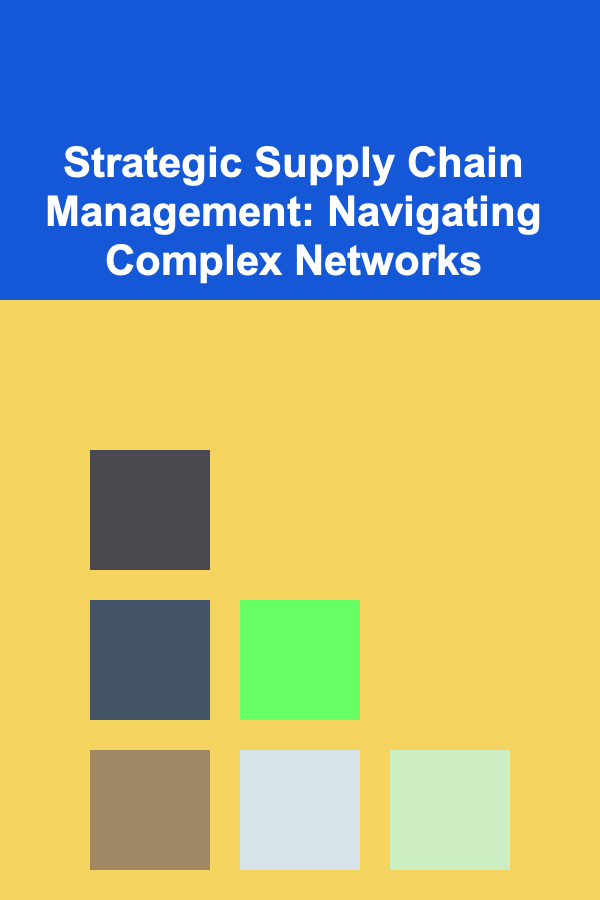
Strategic Supply Chain Management: Navigating Complex Networks
ebook include PDF & Audio bundle (Micro Guide)
$12.99$10.99
Limited Time Offer! Order within the next:

Supply chain management (SCM) has evolved into a critical component of global business strategy. In an increasingly interconnected world, businesses no longer operate in isolated silos, but are part of intricate, multi-tiered supply chains that span continents. As businesses strive to gain a competitive edge, strategic supply chain management has become a fundamental differentiator. To thrive in today's complex networks, companies need to develop agile, innovative, and resilient supply chain strategies that can navigate disruptions, capitalize on opportunities, and drive long-term value.
Strategic supply chain management goes beyond the operational focus of moving goods from point A to point B. It is about creating a competitive advantage through thoughtful design, optimization, and alignment with broader business objectives. This actionable guide explores key strategies for navigating the complexity of modern supply chains, focusing on areas such as network design, risk management, collaboration, and digital transformation.
Understanding the Dynamics of Modern Supply Chains
In today's global marketplace, supply chains have evolved into complex networks that involve numerous stakeholders across various regions. These stakeholders include suppliers, manufacturers, distributors, retailers, logistics providers, and customers. The complexity arises from the interconnectedness of these players, which creates both opportunities and challenges.
Modern supply chains are characterized by:
- Globalization: Sourcing materials from different parts of the world and catering to markets on multiple continents.
- Technology Integration: Leveraging cutting-edge technologies like Artificial Intelligence (AI), the Internet of Things (IoT), and blockchain to streamline operations.
- Supply Chain Transparency: Increased visibility through data analytics, real-time monitoring, and better communication with partners.
- Evolving Customer Expectations: A demand for faster deliveries, greater product customization, and sustainability, all of which require flexibility and speed.
Strategic supply chain management involves the orchestration of these diverse elements to create a streamlined, cost-effective, and agile system that can withstand the pressures of the modern economy.
Designing a Resilient Supply Chain Network
One of the foundational principles of strategic supply chain management is network design. An optimized supply chain network ensures that resources flow efficiently, costs are minimized, and the company can respond swiftly to changes in demand or disruptions.
Actionable Strategies for Network Design:
- Identify Core Competencies: A company's supply chain network should be designed around its core competencies. Identify where you can add the most value and focus on building a network that supports these strengths. For example, if a company specializes in high-tech products, the network should be designed to accommodate rapid prototyping, high-quality standards, and quick-to-market timelines.
- Strategic Location Decisions: Location plays a crucial role in supply chain design. Evaluate locations based on factors like proximity to suppliers and customers, labor availability, transportation infrastructure, and regulatory environment. Nearshoring (moving production closer to home markets) has become an increasingly popular strategy to reduce lead times and mitigate risks from global disruptions.
- Tiered Supplier Relationships: Consider a multi-tier supplier strategy that includes a mix of primary and secondary suppliers. Diversifying suppliers across multiple geographies and ensuring that critical materials have multiple sources helps mitigate the risks posed by disruptions, such as natural disasters or geopolitical instability.
- Lean vs. Resilient Trade-Off: The traditional lean supply chain focuses on minimizing waste and inventory costs. However, in today's environment, resilience is also essential. A resilient supply chain is capable of absorbing shocks while maintaining performance levels. It's essential to strike a balance between these two approaches. For example, implementing buffer stock for critical components can help absorb supply disruptions without excessive inventory costs.
Integrating Risk Management into Supply Chain Strategy
Risk management is a crucial aspect of strategic supply chain management. As supply chains become more global and complex, the exposure to risks increases. These risks can take many forms, from geopolitical tensions and trade tariffs to natural disasters, cyberattacks, and supply shortages.
Actionable Risk Management Strategies:
- Develop a Comprehensive Risk Map: Identify the risks that could affect various elements of your supply chain---whether it's sourcing, production, transportation, or delivery. Use a risk mapping tool to visualize and assess the likelihood and impact of potential disruptions. Common risks include currency fluctuations, changes in trade policy, and disruptions from weather events.
- Establish Contingency Plans: Once risks are mapped, create contingency plans for each. This includes identifying backup suppliers, alternate routes for transportation, and emergency protocols for production stoppages. The key to resilience is not just responding to disruptions but having preemptive plans in place to ensure continuity.
- Diversification of Suppliers and Logistics Providers: Relying on a single supplier or logistics provider can expose a company to substantial risk. It's critical to diversify supply sources across different regions, industries, and market conditions. Similarly, diversify logistics providers to avoid over-reliance on one carrier, which could lead to costly delays or service disruptions.
- Monitor Emerging Risks: Leverage real-time data and analytics to monitor supply chain operations and identify emerging risks before they become significant issues. IoT sensors, big data, and AI-powered tools can provide real-time insights into the health of your supply chain, giving you the ability to react swiftly to problems.
Collaboration and Partnering Across the Supply Chain
A key component of strategic supply chain management is collaboration. Strong partnerships with suppliers, distributors, and even competitors can lead to shared benefits, increased efficiency, and greater innovation.
Actionable Collaboration Strategies:
- Supplier Relationship Management (SRM): Rather than viewing suppliers as mere vendors, develop collaborative, long-term relationships. Involve them in the planning process, share forecasts, and align on common goals. This helps ensure consistent quality, better pricing, and on-time delivery.
- Collaborative Planning, Forecasting, and Replenishment (CPFR): CPFR is a framework that allows companies and their suppliers to share information on inventory levels, sales forecasts, and production schedules. This shared visibility fosters better decision-making and reduces the risk of stockouts or excess inventory.
- Cross-Functional Collaboration: Ensure that different departments within your company (e.g., sales, marketing, procurement, logistics) are collaborating effectively. A sales team may have insights into customer trends, which could impact procurement decisions. Meanwhile, procurement teams can offer insights into supply challenges that affect marketing campaigns. Cross-functional communication ensures alignment and facilitates agile responses to market changes.
- Collaborating with Competitors (Co-opetition): Sometimes, it makes sense to collaborate with competitors on certain aspects of the supply chain, such as logistics or joint product development. This concept, known as co-opetition, can create economies of scale and lower operational costs for all parties involved.
Embracing Digital Transformation in Supply Chains
Digital technologies are reshaping supply chain management, enabling greater transparency, efficiency, and responsiveness. Embracing digital transformation is not optional---it's imperative for businesses looking to remain competitive.
Actionable Digital Transformation Strategies:
- Adopt Cloud-Based Solutions: Cloud-based platforms provide real-time visibility across your entire supply chain. These platforms allow you to track inventory levels, order statuses, and transportation routes in real time, making it easier to manage operations, improve communication, and make data-driven decisions.
- Leverage Big Data and Analytics: Big data allows businesses to analyze large volumes of data to identify patterns, trends, and opportunities for improvement. Predictive analytics can optimize demand forecasting, inventory management, and even route planning. By tapping into big data, businesses can anticipate issues before they arise and make proactive adjustments to the supply chain.
- Implement Blockchain for Transparency and Security: Blockchain technology offers a secure, transparent way to track products through the supply chain, from raw material sourcing to final delivery. Blockchain can be particularly useful for industries where transparency is critical, such as pharmaceuticals, food, and luxury goods.
- Adopt Internet of Things (IoT) for Real-Time Monitoring: IoT sensors can track the movement and condition of goods as they move through the supply chain. Temperature-sensitive products, such as pharmaceuticals and food, can benefit from IoT by ensuring they are stored and transported under optimal conditions. Furthermore, IoT can help in preventive maintenance by monitoring machinery performance, reducing downtime.
Continuous Improvement and Adaptation
In the dynamic world of supply chain management, strategies that worked yesterday may not work tomorrow. The key to long-term success is continuous improvement and the ability to adapt quickly to changing circumstances.
Actionable Continuous Improvement Strategies:
- Lean and Six Sigma Methodologies: Adopt Lean principles to eliminate waste and improve efficiency throughout the supply chain. Combine Lean with Six Sigma to focus on process improvement and defect reduction. These methodologies help businesses identify inefficiencies, streamline operations, and reduce costs.
- Regularly Review Performance Metrics: Track key performance indicators (KPIs) such as on-time delivery, order accuracy, transportation costs, and inventory turnover. Use these metrics to assess the effectiveness of your supply chain and identify areas for improvement. Regularly review and adjust your strategy based on performance.
- Stay Agile and Flexible: The most successful supply chains are those that can pivot when faced with unforeseen circumstances. Build agility into your processes by focusing on speed, flexibility, and scalability. For instance, introducing modular inventory systems or agile procurement strategies allows companies to quickly adjust to market fluctuations.
Conclusion
Strategic supply chain management is a complex, multifaceted discipline that requires careful planning, constant vigilance, and the ability to adapt to new technologies and shifting market conditions. By focusing on network design, risk management, collaboration, digital transformation, and continuous improvement, businesses can navigate the complexities of modern supply chains while creating long-term value.
In a world where disruptions are increasingly common and customer expectations are rising, the companies that succeed will be those that approach supply chain management as a strategic advantage. Through thoughtful planning and proactive action, businesses can build resilient, efficient, and innovative supply chains that drive growth and strengthen their competitive position.

Customer Journey Mapping: A Comprehensive Guide for Customer Insights Analysts
Read More
How to Clean Your Carpet Without a Carpet Cleaner
Read More
How to Set Up a Cozy Family Reading Corner at Home
Read More
Why You Need to Set Goals for Home Organization Projects
Read More
How to Handle Holidays and Special Occasions During Weight Loss
Read MoreHow to Handle Unexpected Expenses While Tracking Your Emergency Fund
Read MoreOther Products

Customer Journey Mapping: A Comprehensive Guide for Customer Insights Analysts
Read More
How to Clean Your Carpet Without a Carpet Cleaner
Read More
How to Set Up a Cozy Family Reading Corner at Home
Read More
Why You Need to Set Goals for Home Organization Projects
Read More